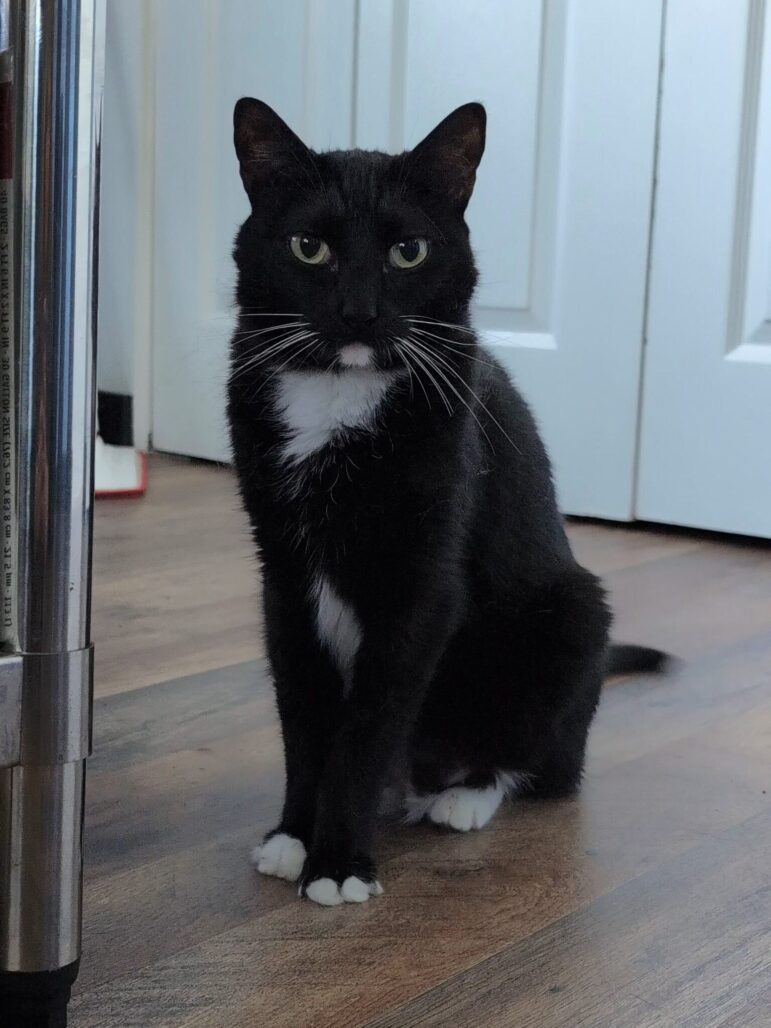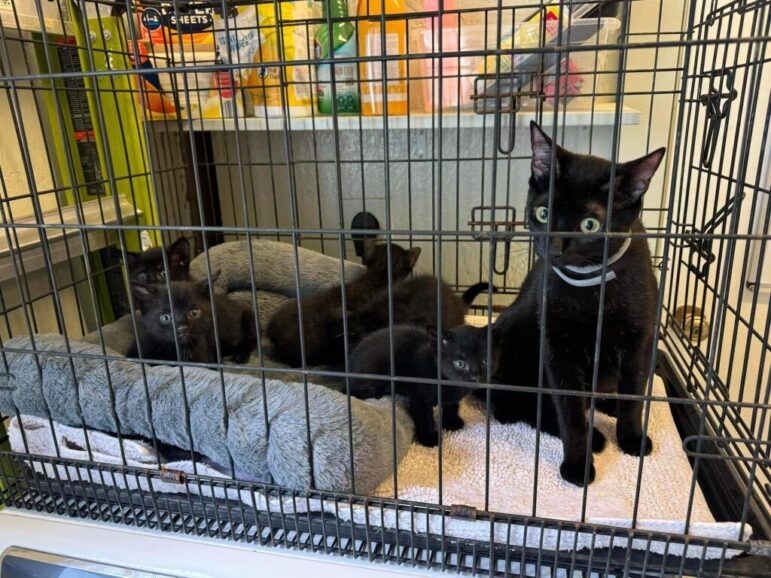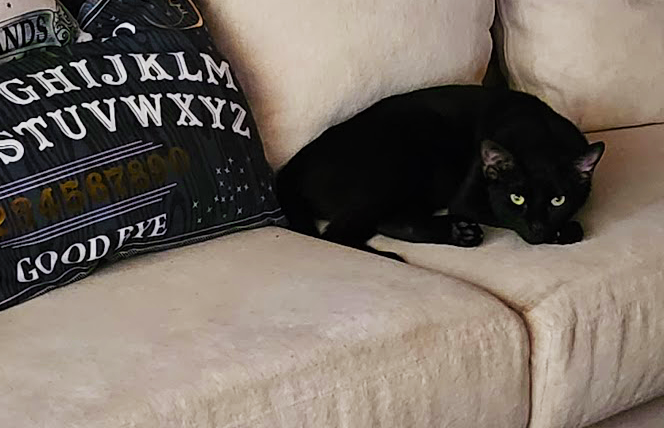Asheville, N.C. – This Saturday, August 17 marks the 13th anniversary of National Black Cat Appreciation Day. While the favorability of black cats when it comes to adoption have risen slightly in recent years, they continue to have lower adoption rates when measured against other colors of cats. Unfortunately, they still have much higher euthanasia rates.
According to The National Database of Shelter Animals Count, reporting data from Shelter Animals Count (SAC), the most respected source for animal sheltering data, 690,000 animals were euthanized in 2023 and 330,000 of those animals were cats. The total intake number of animals reported by shelters to the database for 2023 was over 6.5 million—3.3 million cats and 3.2 million dogs in the U.S. No data was readily available as to the breakdown of how many of those animals were black.
Last year, 2023, marked the first year since the organization started collecting data in 2012 that dogs had both higher shelter intake numbers and higher rates of euthanasia (360,000) than in the previous five years. According to the data collected, 65% of the live outcomes of the cats held by shelters were attributed to adoption, while dog adoption rates fell to 56%.
Overall, this is good news for cats but not necessarily good news for black cats. There is still a significant bias against black cats in many parts of the U.S., as well as the rest of the world.
A Multidisciplinary Digital Publishing Institute (MDPI) study published in 2020 showed that the rate for euthanasia of black cats at 74.6% was the highest with the lowest adoption rates of 10%. The study analyzed outcomes for nearly 8000 cats admitted to an urban public shelter in the state of Kentucky from 2010 through 2011.
While things have improved slightly, on average, black cats endure longer stays in shelters and rescues. While age and overall health are often determining factors in adoption rates, the color of a cat’s coat ranks near the top when it comes to deciding factors.

Black Cats in the Black Cat Lounge – courtesy
The gene found in cats responsible for producing black coats is also dominant, which means there are more black cats than any other color. In order for a kitten to be black just one of its parents have to carry the black gene. It’s a bit of a double whammy for black cats—more black cats and drastically lower adoption rates.
There is also a certain irony in all of this because recent research indicates that black cats may be more resistant to disease, like feline HIV. The dominance of the gene responsible for black fur may be more of a factor of evolution and survival of the species. Researchers have been studying feline genetics in hopes of providing better understanding of possible genetic mutations in humans to ward off disease.
Despite any value scientific or other positive attributes that black cats might offer, they still are often the subject of abuse, mistreatment, and neglect. What follows are three examples of situations that all occurred within just one week that this reporter was personally involved with.
First, a truck driving slowly through a residential neighborhood rolled down the window and tossed out a black kitten into a neighbor’s front yard and then speedily drove away. An adjacent neighbor to the yard where the kitten was tossed notified the neighbor who contacted the facility that ultimately took in the kitten.
Next, a woman who claimed she was moving out of state left one of her cats in a carrier on the front steps of House of Black Cat Magic. She was unaware that anyone was outside and when questioned she said, “I’m moving to [state name withheld] and can only take one cat. I thought about leaving her in the hotel but wasn’t sure what they might do with her, so I brought her here. I feel kind of bad ‘cause this cat really likes me but she is declawed and fixed.” She got back in the car and simply drove off.
The black & white tuxedo cat was chipped and the records provided listed when the cat was adopted and that it is approximately 10 years old. When the chip company called the phone number listed to verify that this was an owner surrender in order to update the animal’s information, the woman who answered the phone used some profanity and then hung up.

Cat renamed Mazzy May was left on the front porch of HBCM – courtesy of S. Nerenberg
Finally, and perhaps the worst anecdote, a local shelter received a black female cat with five black kittens. They were found in a black trash bag that had been tied closed and left on the side of the interstate. A passerby noticed the trash bag was moving and stopped to investigate. The mama cat was wearing a flea collar and all of the kittens were in very good shape, which suggests that someone had been caring for them and providing support. It also suggests that is unlikely that the person who left them on the side of the interstate in a sealed trash bag was the same person. The mama cat now named Gladys, and the five Pips are now safe and will be cared for until they can all find their forever homes.

Gladys & her 5 kittens, dubbed the Pips who left in a sealed trash bag on the side of the interstate – courtesy of Binx’s Home for Black Cats
These are the kinds of stories that anyone who works in animal welfare experience every day. And while most folks who work in the field of animal rescue try to reserve judgment, a steady diet of these types of situations can take its toll. The balance is struck by dispelling some of the negative myths surrounding all animals, but especially black cats, and by finding loving homes for as many as possible.

Vladi establishing control at TWH HQ
Several rescues across the country are solely focused on saving black cats. Binx’s Home for Black Cats is one of the few to recognize that Pagans and Witches were an untapped market when it came to homing black cats. They kindly provided TWH with a statement on the continued importance of National Black Cat Appreciation Day:
“Holidays like Black Cat Appreciation Day are so important because even though black cat adoptions are on the rise, there are more complicated issues that could be remedied partially just by spreading awareness. Black cats are still the most likely color of cat to end up in US shelters and they often spend more time in the shelter before adoption.
“Furthermore, because a lot of the public still believe that black cats are harder to adopt out, shelter systems may even assume that a black cat is “less adoptable” and therefore they also still have the highest euthanasia rate. While most animal welfare organizations, staff, and administrators put the animals first- they often have to make impossible choices while dealing with pressure from all sides.
“Organizations like Binx’s Home for Black Cats help by acting as a pipeline for black cats that may end up on euthanasia lists due to these public misconceptions and lack of resources and holidays like Black Cat Appreciation Day give us yet another reason to highlight animal rights and welfare for the most magical of creatures: the black cat!”
So, it would seem that we certainly still need a day that celebrates black cats and all the wonderful attributes they have to offer. You know what they say, “Once you go black, you won’t go back.”
The Wild Hunt is not responsible for links to external content.
To join a conversation on this post:
Visit our The Wild Hunt subreddit! Point your favorite browser to https://www.reddit.com/r/The_Wild_Hunt_News/, then click “JOIN”. Make sure to click the bell, too, to be notified of new articles posted to our subreddit.
